Selina Concise Physics Class 9 ICSE Solutions Reflection of Light
Selina ICSE Solutions for Class 9 Physics Chapter 7 Reflection of Light
Exercise 7(A)
Solution 1S.
The return of light into the same medium after striking a surface is called reflection.
Solution 2S.
Black silvered surface reflects most of the light incident on it.
Solution 3S.
(a) Plane mirror: Plane mirror is a highly polished and smooth reflecting surface made from a clear plane glass sheet, usually thin and silvered with suitable reflecting abrasive (for example, mercury) on one side. Once this pasting is done, then the glass becomes opaque but due to the reflecting property of the abrasive, the plane glass sheet becomes a plane glass reflector or a plane glass mirror.
(b) Incident ray: The light ray striking a reflecting surface is called the incident ray.
(c) Reflected ray: The light ray obtained after reflection from the surface, in the same medium in which the incident ray is travelling, is called the reflected ray.
(d) Angle of incidence: The angle which the incident ray makes with the normal at the point of incidence is called the angle of incidence. It is denoted by the letter i.
(e) Angle of reflection: The angle which the reflected ray makes with the normal at the point of incidence is called the angle of reflection. It is denoted by the letter r.
Solution 4S.
Regular reflection occurs when a beam of light falls on a smooth and polished surface and irregular reflection occurs when a beam of light falls on a rough surface. Since the surface is uneven, from different points light rays get reflected in different directions and give rise to irregular reflection.
Solution 5S.
Reflection of light from a plane mirror is regular reflection and reflection of light from plane sheet of paper is irregular reflection of light.
Solution 6S.
Laws of reflection:
The angle of incidence is equal to the angle of reflection.
The incident ray, the reflected ray and the normal at the point of incidence, lie in the same plane.
Solution 7S.
Laws of reflection:
- The angle of incidence is equal to the angle of reflection.
- The incident ray, the reflected ray and the normal at the point of incidence, lie in the same plane.
Experiment to verify the laws of reflection:
Fix a white sheet of paper on a drawing board and draw a line MM1 as shown in figure. On this line, take a point O nearly at the middle of it and draw a line OA such that ∠MOA is less than 90o. Then draw a normal ON on line MM1 at the point O, and place a small plane mirror vertical by means of a stand with its silvered surface along MM1.
Next fix two pins P and Q at some distance (≈5 cm) apart vertically on line OA, on the board. Keeping eye on the other side of normal (but on the same side of mirror), see clearly images P’ and Q’ of the pins P and Q. Next fix a pin R such that it is in line with the images of pins P and Q as observed in the mirror. Next, fix one more pin S such that the pin S is in line with the pin R as well as images P’ and Q’ of pins P and Q.
Draw small circles on paper around the positions of pins as shown in figure. Remove the pins and draw a line OB joining the pin points S and R, which meets the surface of mirror at O. The angles AON and BON are measured and recorded.
The experiment is then repeated for the angle of incidence ∠AON equal to 40o, 50o, 60o.
From results, it is observed that angle of incidence is equal to the angle of reflection. This verifies the first law of reflection.
The experiment has been performed on a flat drawing board, with mirror normal to the plane of board on which white sheet of paper is being fixed. Since the lower tips of all the pins also lie on the same plane (i.e., the plane of paper), it proves the second law of reflection.
Solution 8S.
Solution 9S.
Solution 10S.
(a) Angle of incidence = 90o – 30o = 60o
(b) Angle between the incident ray and reflected ray = Angle of incidence + Angle of reflection
Angle of reflection = Angle of incidence = 60o
Therefore, Angle between the incident ray and reflected ray = 60o + 60o = 120o
Solution 11S.
Solution 12S.
Solution 13S.
(a) Three characteristics of image formed by plane mirror:
- Image formed in erect (upright)
- Image formed is virtual
- Image formed is of the same size as the object
(b) The image is situated at the same perpendicular distance behind the mirror as the object in front of it.
Solution 14S.
Solution 15S.
The interchange of the left and right sides in the image of an object in a plane mirror is called lateral inversion.
Figure above shows the image formation of a letter P in a plane mirror.
Solution 16S.
The letters on the front of a ambulance are written laterally inverted, so that the driver of the vehicle moving ahead of the ambulance reads these words laterally inverted as AMBULANCE, in his rear view mirror, and gices side to pass the ambulance first.
Solution 17S.
Due to lateral inversion, , it becomes difficult to read the image of the text of a page formed due to reflection by a plane mirror.
Solution 1M.
i = r
Solution 2M.
Erect and of same size
Solution 3M.
virtual with lateral inversion
Solution 1N.
Angle of incidence (i) + Angle of reflection(r) = 90o
But, as per the laws of reflection, i = r
Therefore, 2 i = 90o
Or, i = r = 45o
Solution 2N.
Distance between man and his image = 6m
Distance between man and mirror + distance between mirror and image = 6m
But, Distance between man and mirror (object distance) = distance between mirror and image (image distance)
Therefore, distance of man from mirror = 6/2 = 3m
Solution 3N.
(a) Image of the insect is formed 1m behind the mirror.
(b) Distance between the insect and his image = 1 + 1 = 2 m
Solution 4N.
Initially, distance of the object from the mirror = 60 cm.
Therefore, image is formed at a distance 60 cm from the mirror, behind it.
Thus, initial distance between the object and image = 60 + 60 = 120 cm
If the mirror is moved 25 cm away from the object,
The new distance of the object from the mirror = 60 + 25 = 85 cm
The new image is now at a distance 85 cm from the mirror behind it.
Thus, new distance of the image from the object = 85 + 85 = 170 cm
Taking the position of the object as reference point, the distance between the two positions of the image = new distance of image from the object – initial distance of the image from the object
= (170 – 120) cm = 50 cm
Thus, the image shifts 50 cm away.
Solution 5N.
Distance between man and chart = 3m
Distance between man and mirror = 2m
Therefore, distance between chart and mirror = 5 m
Now, final image is formed on the mirror, which is at a distance of 2 m from the man, therefore, the chart as seen by patient is (5m + 2m =) 7m away.
Exercise 7(B)
Solution 1S.
If two mirrors make an angle θ with each other and object is placed in between the two mirrors, the number of images formed is n or (n – 1) depending upon n = 360o / θo is odd or even.
(a) If n = 360o / θo is odd,
(i) The number of images formed is n, when the object is placed asymmetrically between the mirrors.
(ii) The number of images formed is n-1, when the object is placed symmetrically between the mirrors.
(b) If n = 360o / θo is even, the number of images is always n-1.
Solution 2S.
Solution 3S.
For two mirrors kept perpendicular to each other, three images are formed for an object kept in between them.
Solution 4S.
For two mirrors kept parallel to each other, an infinite number of images are formed for an object kept in between them.
Solution 5S.
Two uses of plane mirror:
In barber’s shop for seeing the hairs at the back of head, two mirrors facing each other are fixed on opposite walls at the front and back of the viewer.
In solar heating devices such as a solar cooker, solar water heater, etc., a plane mirror is used to reflect the incident light rays from sun on the substance to be heated.
Solution 1M.
5
Solution 2M.
In a barber’s shop, two plane mirrors are placed parallel to each other.
Solution 1N.
(a) Angle between the mirrors, θ = 90o
Now, n = 360o / θo = 360o / 90o = 4, which is even.
Hence number of images formed will be (n-1); i.e., 4-1 = 3 images
(b) Angle between the mirrors, θ = 60o
Now, n = 360o / θo = 360o / 60o = 6, which is even.
Hence number of images formed will be (n-1); i.e., 6-1 = 5 images
Solution 2N.
Angle between the mirrors, θ = 50o
Now, n = 360o / θo = 360o / 50o = 7.2 7, which is odd.
(i) When placed asymmetrically, number of images formed will be n, i.e. 7.
(ii) When placed symmetrically, number of images formed will be (n-1); i.e. 7-1 = 6 images
Exercise 7(C)
Solution 1S.
A reflecting surface which is a part of a sphere is called a spherical mirror.
Solution 2S.
Two kinds of spherical mirrors are concave and convex.
Distinction between concave and convex mirror: A concave mirror’s bulging surface is silvered and reflection takes place from the hollow surface but a convex mirror’s inner surface is silvered and reflection takes place from the bulging surface.
Solution 3S.
Pole: The geometric centre of the spherical surface of mirror is called the pole of mirror.
Principal axis: It is the straight line joining the pole of the mirror to its centre of curvature.
Centre of curvature: The centre of curvature of a mirror is the centre of the sphere of which the mirror is a part.
Solution 4S.
Solution 5S.
Solution 6S.
Focus of a concave mirror: The focus of a concave mirror is a point on the principal axis through which the light rays incident parallel to principal axis, pass after reflection from the mirror.
Focal length of a concave mirror: The distance of the focus from the pole of the concave mirror is called its focal length.
Solution 7S.
Focus of a convex mirror: The focus of a convex mirror is a point on the principal axis from which, the light rays incident parallel to principal axis, appear to come, after reflection from the mirror.
Focal length of a convex mirror: The distance of the focus from the pole of the convex mirror is called its focal length.
Solution 8S.
Incident ray is directed towards the centre of curvature because the ray is normal to the spherical mirror, so ∠i = ∠r = O.
Solution 9S.
Solution 10S.
Solution 11S.
Solution 12S.
Two convenient rays that are chosen to construct the image by a spherical mirror for a given object:
1. A ray passing through the centre of curvature: A ray of light passing through the centre of curvature of a concave mirror or a ray directed in the direction of centre of curvature of a convex mirror is reflected back along the same path after reflection.
2. A ray parallel to the principal axis: A ray of light parallel to the principal axis, after reflection pass through the principal focus in case of a concave mirror or appears to diverge from it in case of convex mirror.
Solution 13S.
Solution 14S.
Solution 16S.
The image formed is virtual, erect and magnified.
Solution 17S.
The image formed is real, inverted and magnified.
Solution 18S.
The image formed is virtual, erect and diminished.
Solution 19S.
Convex mirror always produces erect and virtual images. The images formed are diminished, i.e. the size of the image is shorter than the size of the object.
Solution 20S.
(a) If the object is placed between the pole and focus of a concave mirror, the image formed is magnified and erect.
(b) The image is virtual.
Solution 21S.
(a) If the object is placed at the centre of curvature of a concave mirror, the image formed is of same size.
(b) The image formed is real and inverted.
Solution 22S.
(a) An image which can be obtained on a screen is called a real image.
(b) A concave mirror can be used to obtain a real image of an object.
(c) No, it does not form real image for all locations of the object.
Solution 23S.
When an object is moved from infinity towards the pole of mirror, the image formed moves away from the mirror. The image formed is real and inverted.
Solution 24S.
In a convex mirror, the image formed is always virtual, upright and diminished. It is always situated between its pole and focus, irrespective of the distance of object in front of the mirror.
Solution 25S.
(a) Concave, (b) Concave, (c) Convex and (d) Concave
Solution 26S.
Solution 27S.
Solution 28S.
Solution 29S.
The image formed by a convex mirror is always between pole and focus. Hence, the maximum distance that can be obtained in convex mirror is the focal length. For this case the object has to be at infinity.
Solution 30S.
The maximum distance that can be obtained in concave mirror is infinity. For this case the object has to be at focus.
Solution 31S.
To distinguish between a plane mirror, concave mirror and convex mirror, the given mirror is held near the face and image is seen. There can be following three cases:
Case (i): If the image is upright, of same size and it does not change in size by moving the mirror towards or away from the face, the mirror is plane.
(ii) If the image is upright and magnified, and increases in size on moving the mirror away, the mirror is concave.
(iii) If the image is upright and diminished and decreases in size on moving the mirror away, the mirror is convex.
Solution 32S.
Two uses of concave mirror:
It is used as a shaving mirror.
It is used as reflector in torch, head light of automobiles etc.
Solution 33S.
(a) Concave mirror
(b) Concave mirror
Solution 34S.
(a) The person’s face is between the pole and focus of the mirror.
(b) The image formed is erect, virtual and magnified.
Solution 35S.
A convex mirror is preferred as a rear view mirror because it has a wider field of view as compared to a plane mirror of same size.
Solution 36S.
A convex mirror diverges the incident beam and always forms a virtual, small and erect image between its pole and focus. Thus, a driver can see all the traffic approaching from behind. This fact enables the driver to use it as a rear view in vehicles to see all the traffic approaching from behind.
Solution 1M.
Retraces its path
Solution 2M.
Erect and diminished
Solution 3M.
Concave mirror
Solution 1N.
Focal length = ½ (Radius of curvature)
Or, f = 40/2 = 20 cm
Solution 2N.
Radius of curvature = 2 x focal length
Or, R = 2f = 2 x 10 = 20 cm
Solution 3N.
The image is 30 cm in front of the mirror, 3 cm high, real, inverted and magnified.
Solution 4N.
The image is 6 cm behind the mirror.
Yes the image is magnified.
Solution 5N.
The size of the image is equal to the size of the object if the object is placed at the centre of curvature of a concave mirror.
Hence, the object should be placed at 50 cm.
Solution 6N.
The position of the object is 12 cm in front of the mirror.
Its size is 1 cm.
Solution 7N.
Solution 8N.
A ray passing parallel to the principal axis passes through the focal point after reflection. Hence, the focal length is 12 cm.
Solution 9N.
Solution 10N.
Solution 11N.
Solution 12N.
Solution 13N.
Solution 14N.


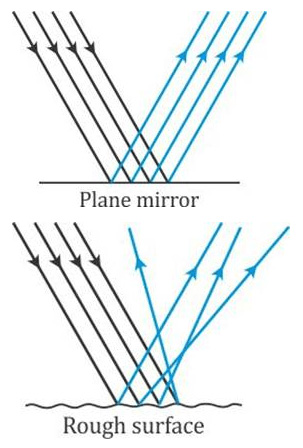









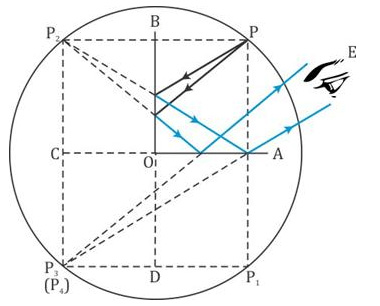


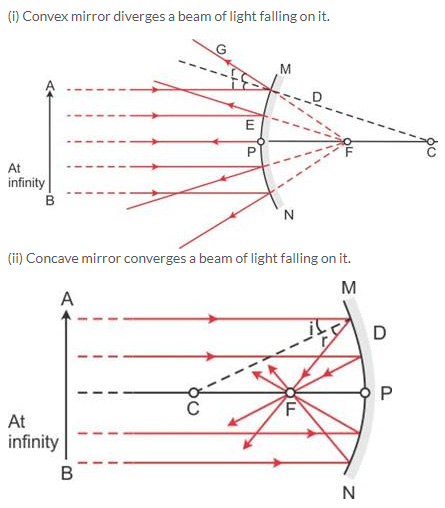















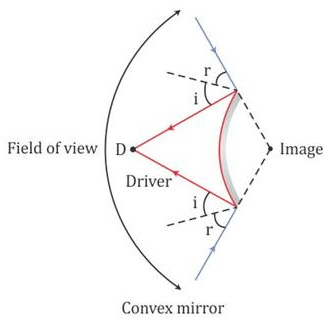










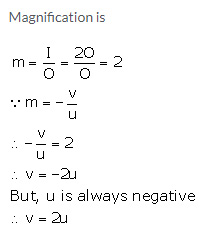

Comments
Post a Comment